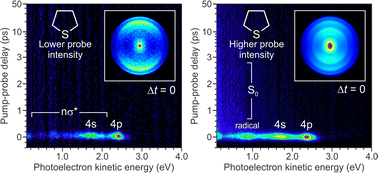Photochemical carbon–sulfur bond cleavage in thioethers mediated via excited state Rydberg-to-valence evolution†
Abstract
Time-resolved photoelectron imaging and supporting ab initio quantum chemistry calculations were used to investigate non-adiabatic excess energy redistribution dynamics operating in the saturated thioethers diethylsulfide, tetrahydrothiophene and thietane. In all cases, 200 nm excitation leads to molecular fragmentation on an ultrafast (<100 fs) timescale, driven by the evolution of Rydberg-to-valence orbital character along the S–C stretching coordinate. The C–S–C bending angle was also found to be a key coordinate driving initial internal conversion through the excited state Rydberg manifold, although only small angular displacements away from the ground state equilibrium geometry are required. Conformational constraints imposed by the cyclic ring structures of tetrahydrothiophene and thietane do not therefore influence dynamical timescales to any significant extent. Through use of a high-intensity 267 nm probe, we were also able to detect the presence of some transient (bi)radical species. These are extremely short lived, but they appear to confirm the presence of two competing excited state fragmentation channels – one proceeding directly from the initially prepared 4p manifold, and one involving non-adiabatic population of the 4s state. This is in addition to a decay pathway leading back to the S0 electronic ground state, which shows an enhanced propensity in the 5-membered ring system tetrahydrothiophene over the other two species investigated.

- This article is part of the themed collection: 2022 PCCP HOT Articles


 Please wait while we load your content...
Please wait while we load your content...